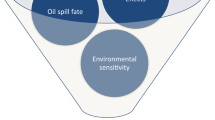Abstract
A departure from ecosystem quality objectives can be defined as effects, which may vary in magnitude and occur over different time scales. Some effects may be reversible while others may persist for long periods. Thus, compared with other sources of pollution in the oceans, the risk of crude oil spillage to the sea presents the major threat for the marine ecology. This study considers the combination of information from diverse sources relating to a similar endpoint in formulating an operational research model to tackle the problem of false alarm from the use of remote sensing in spill detection. A common rubric for this combination is to apply a meta-analysis. The term suggests a move past an analysis of standalone data to one incorporating and synthesizing information from many associated sources.

Similar content being viewed by others
References
Bassey, K.J.: On optimality of marine oil spill pollution control. Int. J. Oper. Res. Optim. 2(2), 215–238 (2011)
Bassey, K.J., Chigbu, P.E.: On optimal control theory of marine oil spill management: a markovian decision approach. Eur. J. Oper. Res. 217(2), 470–478 (2012)
Congalton, R.G.: A review of assessing the accuracy of classifications of remotely sensed data. Remote. Sens. Environ. 37, 35–46 (1991)
Egberongbe, F.A.O., Nwilo, P.C. and Badejo, O.T. (2006): Oil spill disaster monitoring along Nigerian coastline. Promoting land administration and good governance, 5th FIG Regional Conference, Accra, Ghana:1-26
Engelhardt, F.R.: Remote sensing for oil spill detection and response. Pure Appl. Chem. 71(1), 103–111 (1999)
Fleming, W.H., Rishel, R.W.: Deterministic and stochastic optimal control, pp. 1–222. Springer, New York (1975)
Gade, M., Alpers, W.: Using ERS-2 SAR images for routine observation of marine pollution in European coastal waters. Sci. Total Envir. 237–238, 441–448 (1999)
Goodman, R. (1992): Client needs for surveillance and tracking during oil spill. In Proceedings of the First Thematic Conference: Remote Sensing For Marine And Coastal Environments, SPIE 1930: 69-78
Hoveland, E., Johannessen, H.A. and Digranes, J.A. (1994): Slicks detection in SAR images. Proc. of IGARSS’99, Homburg, Germany
Joel, J. (2004): Remote sensing. http://maps.unomaha.edu
Johannessen, H.A., Digranes, J.A., Expedal, G., Samuel, O.M., Browne, P. and Vachon, D.P. (1994): SAR ocean feature catalogue. Esa-Sp-1174
Keramitsoglou, I., Cartalis, C., Kiranoudis, C.: Automatic identification of oil spills on satellite images. Environ. Model. Softw. 21, 640–652 (2006)
Karathanassi, V., Topouzelis, K., Pavlakis, P., Rokos, D.: An object-oriented methodology to detect oil spills. Int. J. Remote. Sens. 27, 5235–5251 (2006)
Mansor, S.B., Assilzadeh, H., Ibrahim, H.M., Mohamed, A.R.: Oil spill detection and monitoring from satellite image. Spill Technol. Newsl. 15(3) (2010)
Marghany, M., Shattri, M. and Ibrahim, Z.Z. (1996): On the application of radarsoft to extract infrastructure details from radarsat. Proc. Of Seminar: Malaysian Remote Sensing Society Conf. on Remote Sensing and GIS.,Lumpur
Marghany, M.: RADARSAT for oil spill trajectory model. Environ. Model. Softw. 19, 473–483 (2004)
Mercier, G., Girard-Ardhuin, F.: Partially supervised oil-slick detection by SAR imagery using kernel expansion. IEE Trans. Geosci. Remote Sens. 44(10), 2839–2846 (2006)
Pavlakis, P. (1996): Investigation of the potential of ERS-1/2 SAR images for monitoring oil spills on the sea surface. Joint Research Centre, European Commission Report EUR 16351EN
Redondo, J.M., Platonov, A.K.: Self-similar distribution of oil spills in european coastal waters. Environ. Res. Lett. 4, 1–10 (2009)
Suter II, G.W.: Ecological risk assessment. Lewis Publishers, Chelsea (1993)
Topouzelis, K.N.: Oil spill detection by SAR images: dark formation detection, feature extraction and classification algorithms. Sensors 8, 6642–6659 (2008)
Woodcock, C.E.: Uncertainty in remote sensing. In: Foody, G.M., Atkinson, P.M. (eds.) Uncertainty in remote sensing and GIS, pp. 18–24. John Wiley & Sons Ltd, Chichester (2002)
Xiaobo, C., Shanker, N.J., Wang, S.S.Y.: Development and application of oil spill model for singapore coastal waters. J. Hydraul. Eng. 129(7), 495–503 (2003)
Xu, X., Pang, S.: Briefing of activities relating to the studies on environmental behaviour and economic toxicity of toxic organics. J. Environ. Sci. 4(4), 3–9 (1992)
Author information
Authors and Affiliations
Corresponding author
Rights and permissions
About this article
Cite this article
Bassey, K.J. A theoretical framework for optimal observability and detectability of spilled oil in aquatic environment. OPSEARCH 49, 430–441 (2012). https://doi.org/10.1007/s12597-012-0090-5
Accepted:
Published:
Issue Date:
DOI: https://doi.org/10.1007/s12597-012-0090-5




